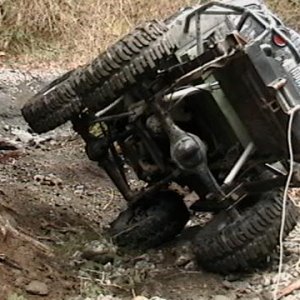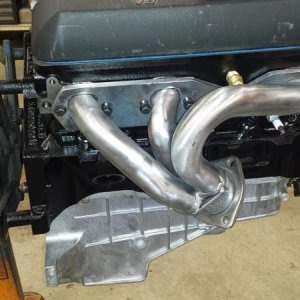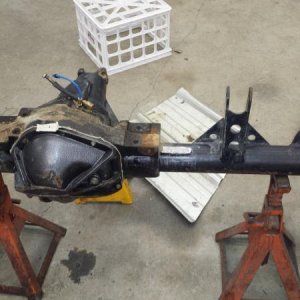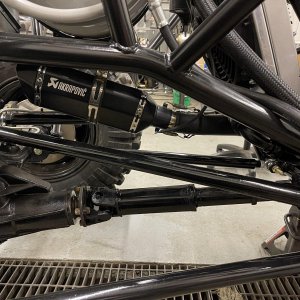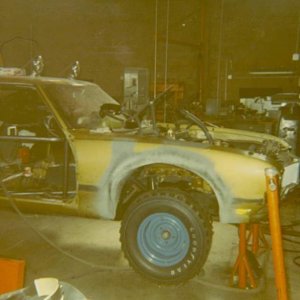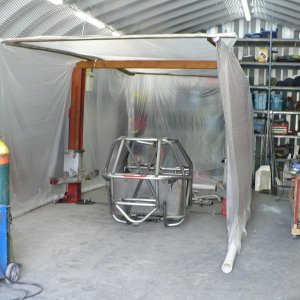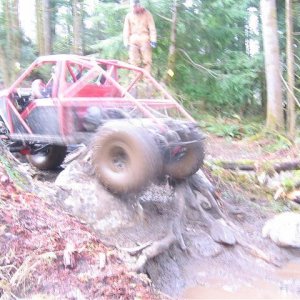-
Help Support Hardline Crawlers :
You are using an out of date browser. It may not display this or other websites correctly.
You should upgrade or use an alternative browser.
You should upgrade or use an alternative browser.
Pics of your shops/garages/specs
- Thread starter NOVI FED COUPE
- Start date
kmcminn
Well-Known Member
- Joined
- Nov 9, 2009
- Messages
- 5,923
- Reaction score
- 142
TacomaJD said:So when they pour concrete, they just gonna lay a bed of gravel down, form it, and fill it up even with the bottom of the shop walls? So in those high spots, the concrete will be what looks like 6-8+ inches thick?
Don't forget a moisture barrier inbetween the concrete and gravel.
TacomaJD
I LIKE CHEAP STUFF.....
kmcminn said:Don't forget a moisture barrier inbetween the concrete and gravel.
Definitely, my old shop had it. Was mainly trying to pinpoint how he planned to compensate for the big gaps between ground and walls.
TBItoy
Well-Known Member
If I can get my shop house sold I'll be buying another house and building another shop.
Gonna do some stuff different this time. Fully insulated with the good vinyl back fiberglass, taller high clearance trusses, open side shed
Sent from my iPhone using Tapatalk
Gonna do some stuff different this time. Fully insulated with the good vinyl back fiberglass, taller high clearance trusses, open side shed
Sent from my iPhone using Tapatalk
Jduck
Well-Known Member
I'm right in the middle of building a 30x40x12 red iron building. It will have freestand 12' awning on the 40' wall over the garage doors. It's still a few weeks from being erected but price wise it's very close to what a pole barn or carport structure was going to cost.




ForMud
Well-Known Member
kmcminn said:Don't forget a moisture barrier inbetween the concrete and gravel.
10 mil poly works fine.
You can get away with 4" concrete unless your planning on putting some heavy trucks, equipment, machinery in there. Then your better off with 6" or 8", and in ether case plan on put reinforcement wire, rebar or fiber in the concrete.
One other thing to keep in mind. If your planning on putting a lift in there, put a hunch a couple of inches deeper around the area where the posts are going to be.
I had plans to do another all steel building. I had found a good price on a 30x40x12 red iron building from heritage steel buildings. It was going to be close to $11k delivered. No insulation in that price and I would have had to erect it myself. Not that big of a deal as I've done one before. But now with young kids my time is way more valuable.
I've got a contractor doing the concrete and a vapor barrier and mesh will be used. No way in hell I'm attempting a 30x50 pad by myself! I do plan on a 2 post lift in the future.
I'm happy with it so that's what matters the most.
I've got a contractor doing the concrete and a vapor barrier and mesh will be used. No way in hell I'm attempting a 30x50 pad by myself! I do plan on a 2 post lift in the future.
I'm happy with it so that's what matters the most.
So I've had 2 people tell me not to use the vinyl insulation or any sheet style type on the interior walls. They said it bows, rips and tears over time. Looks like crap and falls apart.
Is this true?
They both said they would have spent the money for spray foam had they known
I'm told my guys will dig 6 piers. All 3ft deep. Has anyone had any slab cracks or foundation issues that I should be aware of and plan for?
Is this true?
They both said they would have spent the money for spray foam had they known
I'm told my guys will dig 6 piers. All 3ft deep. Has anyone had any slab cracks or foundation issues that I should be aware of and plan for?
TacomaJD
I LIKE CHEAP STUFF.....
Company I work for has made two big additions on to our main plant, both of which have been there much longer than the 12 years I've worked there. One climate controlled, and one non climate controlled. Both additions used the vinyl backed insulation and it still looks good. Now there are no liner panels in some areas and workers have tore it all to ****, but the higher areas unreached by humans all still looks perfectly fine. Get 8' liner panels on all walls and you should be good for a long time.
I've also heard of people using chicken wire laid down first, then lay the insulation, then screw the metal siding on. This keeps the vinyl from drooping/falling over time.
Also, not sure how to find out, but there are probably different brands made better than the others? Could explain why some may last longer than others. All my buddies that have built red iron shops have used the vinyl backed insulation. The stuff is pretty durable, I'd say MUCH more durable than the bubble pack type insulation some cheapo builders offer.
The body shop my dad works at has the spray insulation. No doubt it works good, just looks ugly as **** to me if the walls are gonna be left exposed, plus I understand the cost difference between that and vinyl backed inaulation is quite steep.
If I was building a shop tomorrow, it would have vinyl backed insulation in it.
Sent from my SM-G930V using Tapatalk
I've also heard of people using chicken wire laid down first, then lay the insulation, then screw the metal siding on. This keeps the vinyl from drooping/falling over time.
Also, not sure how to find out, but there are probably different brands made better than the others? Could explain why some may last longer than others. All my buddies that have built red iron shops have used the vinyl backed insulation. The stuff is pretty durable, I'd say MUCH more durable than the bubble pack type insulation some cheapo builders offer.
The body shop my dad works at has the spray insulation. No doubt it works good, just looks ugly as **** to me if the walls are gonna be left exposed, plus I understand the cost difference between that and vinyl backed inaulation is quite steep.
If I was building a shop tomorrow, it would have vinyl backed insulation in it.
Sent from my SM-G930V using Tapatalk
blacksheep10
XBJRA champ/ 555 and team Nasty codriver
- Joined
- May 22, 2007
- Messages
- 10,442
- Reaction score
- 3
How is the UV resistance on the white stuff? I know the bubble silver stuff falls apart with welding, havne't been around the white vinyl/fiber.
The insulation on the first all steel building I did back in 2000 was just vinyl backed standard 2" stuff. It still looks good to this day. Granted there has been some mishaps of someone hitting it or something but that's nothing some white vinyl tape won the fix. The one I pictured above is fiberglass reinforced vinyl backed 2". Meaning it has fiberglass strands in the vinyl. I imagine it is going to hold up as good as the other.
TacomaJD
I LIKE CHEAP STUFF.....
Regarding the concrete question, I'm no expert but have read a lot and had 1 pad poured myself. The pad I had poured was 20x24 with fiber mix, no other reinforcements whatsoever, however, the perimeter of the pad was poured around 6" thick, while the center was 4". This was to support weight of the shop walls. It didn't take long for one crack about dead center of the pad to form and it only went 3/4 of the way across. Been there for 5 years now, hasn't worsened or caused any problems. Concrete cracks, highly doubt chicken wire or rebar would have helped it.
What would have helped it is better dirt pad prep. I had a fairly thick dirt pad built (on a slope), wet it daily and drove/parked on it daily, but was it compacted perfectly enough within 3 weeks to go ahead and build on? Probably not. It was about 3-4' tall in back and even with ground in the front, and used some sort of dirt that has sort of a clay texture to it. Didn't use traditional chert. The crack that formed in the concrete isn't bad enough to bother me at all though, so I don't wish I had done anythig differently. One of my friends rented one of those motorized compactor machines and packed his pad down every day for a few weeks before he poured his pad, but his shop was gonna be huge and he has plenty money and time to do it all the best way possible. Lol.
The general consensus from research I've done from folks that seem like they know what they are talking about, is that the chicken wire and rebar thing isn't gonna stop cracking, it just keeps the concrete from moving any further to make the crack wider over time. Think about it, if you pour a 4-6" concrete pad, the ground it's built on settles a little over time and creates a low spot under the concrete, you drive onto the concrete in a 7k lb diesel truck, do you really think rebar and chicken wire is gonna provide enough structural support to keep the concrete from cracking to fill the low spot underneath? I'm sure you could go crazy with rebar reinforcement and it would help some, but most people just run it around the perimeter of the pad where it's poured the thickest to support walls, then run chicken wire/mesh wire/ whatever its called across the rest of the pad.
Sent from my SM-G930V using Tapatalk
What would have helped it is better dirt pad prep. I had a fairly thick dirt pad built (on a slope), wet it daily and drove/parked on it daily, but was it compacted perfectly enough within 3 weeks to go ahead and build on? Probably not. It was about 3-4' tall in back and even with ground in the front, and used some sort of dirt that has sort of a clay texture to it. Didn't use traditional chert. The crack that formed in the concrete isn't bad enough to bother me at all though, so I don't wish I had done anythig differently. One of my friends rented one of those motorized compactor machines and packed his pad down every day for a few weeks before he poured his pad, but his shop was gonna be huge and he has plenty money and time to do it all the best way possible. Lol.
The general consensus from research I've done from folks that seem like they know what they are talking about, is that the chicken wire and rebar thing isn't gonna stop cracking, it just keeps the concrete from moving any further to make the crack wider over time. Think about it, if you pour a 4-6" concrete pad, the ground it's built on settles a little over time and creates a low spot under the concrete, you drive onto the concrete in a 7k lb diesel truck, do you really think rebar and chicken wire is gonna provide enough structural support to keep the concrete from cracking to fill the low spot underneath? I'm sure you could go crazy with rebar reinforcement and it would help some, but most people just run it around the perimeter of the pad where it's poured the thickest to support walls, then run chicken wire/mesh wire/ whatever its called across the rest of the pad.
Sent from my SM-G930V using Tapatalk
TBItoy
Well-Known Member
blacksheep10 said:How is the UV resistance on the white stuff? I know the bubble silver stuff falls apart with welding, havne't been around the white vinyl/fiber.
The white vinyl backed fiberglass is great. Tons of welding in my dad's shop over 20 years, no issues.
Bubble wrap is **** and should only be considered a vapor barrier IMO.
ForMud
Well-Known Member
TacomaJD said:Regarding the concrete question, I'm no expert but have read a lot and had 1 pad poured myself. The pad I had poured was 20x24 with fiber mix, no other reinforcements whatsoever, however, the perimeter of the pad was poured around 6" thick, while the center was 4". This was to support weight of the shop walls. It didn't take long for one crack about dead center of the pad to form and it only went 3/4 of the way across. Been there for 5 years now, hasn't worsened or caused any problems. Concrete cracks, highly doubt chicken wire or rebar would have helped it.
What would have helped it is better dirt pad prep. I had a fairly thick dirt pad built (on a slope), wet it daily and drove/parked on it daily, but was it compacted perfectly enough within 3 weeks to go ahead and build on? Probably not. It was about 3-4' tall in back and even with ground in the front, and used some sort of dirt that has sort of a clay texture to it. Didn't use traditional chert. The crack that formed in the concrete isn't bad enough to bother me at all though, so I don't wish I had done anythig differently. One of my friends rented one of those motorized compactor machines and packed his pad down every day for a few weeks before he poured his pad, but his shop was gonna be huge and he has plenty money and time to do it all the best way possible. Lol.
The general consensus from research I've done from folks that seem like they know what they are talking about, is that the chicken wire and rebar thing isn't gonna stop cracking, it just keeps the concrete from moving any further to make the crack wider over time. Think about it, if you pour a 4-6" concrete pad, the ground it's built on settles a little over time and creates a low spot under the concrete, you drive onto the concrete in a 7k lb diesel truck, do you really think rebar and chicken wire is gonna provide enough structural support to keep the concrete from cracking to fill the low spot underneath? I'm sure you could go crazy with rebar reinforcement and it would help some, but most people just run it around the perimeter of the pad where it's poured the thickest to support walls, then run chicken wire/mesh wire/ whatever its called across the rest of the pad.
Sent from my SM-G930V using Tapatalk
You are correct, wire and rebar is to hold the concrete together if it cracks.
One of the ways to help with cracking is the use of control joints... Saw cut, metal screed, or expansion joints are all used to control where is going to crack, so instead of having a wandering crack it's going be cracked in a straight line.
Pad prep is another way. Soil compaction is important as is the type of soil your working with. Topsoil is not going to compact while select soil will. I know some guys will mix in some portland cement to the soil, wetten, then compact.
Then put stone (Ether #57 or crushed concrete ) to help get moisture out from under the pad. This is important up north so it doesn't freeze in the winter.
The PSI of the concrete will make a big difference too. 3500 and up for pads. 3500 and below for footings and walls.
bbone
Well-Known Member
redneckengineered said:Bought an old building that had been a machine shop, then was a granite shop for a few years. Nastiest place you've ever seen. Approximately 5000 s/f plus an office and locker room where I can shower and clean up. Before/after
Tell us about the floor coating and prep
bbtank45
Under Construction
I deal with a lot of abused warehouse floors. Usually in the 350-500ksf. If you have spalling, id recommend a product called 10 minute mender....if you have cracks, id use a polyurea joint sealant or MM-80 (METZGER MCGUIRE). If you want a lasting, easily cleanable slab, id shotblast and epoxy coat. Be prepared to spend some $$.
Jduck
Well-Known Member
Per the recommendation of the building company, the contractor and the county code inspector I decided on a 6" slab with a 12"footer all the way around. Where the anchor bolts are is a 2'x2'x2' footer, rebar all the way around the footer, wire mesh in the center, 3500psi with fiber. Hoping it will be trouble free and look good for many years.
Jduck said:Per the recommendation of the building company, the contractor and the county code inspector I decided on a 6" slab with a 12"footer all the way around. Where the anchor bolts are is a 2'x2'x2' footer, rebar all the way around the footer, wire mesh in the center, 3500psi with fiber. Hoping it will be trouble free and look good for many years.
Did they pour it monolithically or footing/block/concrete? Good call on the 6" slab though.

ADMINISTRATOR
Jduck
Well-Known Member
CHASMAN9 said:Did they pour it monolithically or footing/block/concrete? Good call on the 6" slab though.
ADMINISTRATOR
Monolithic. It should be getting poured today.

